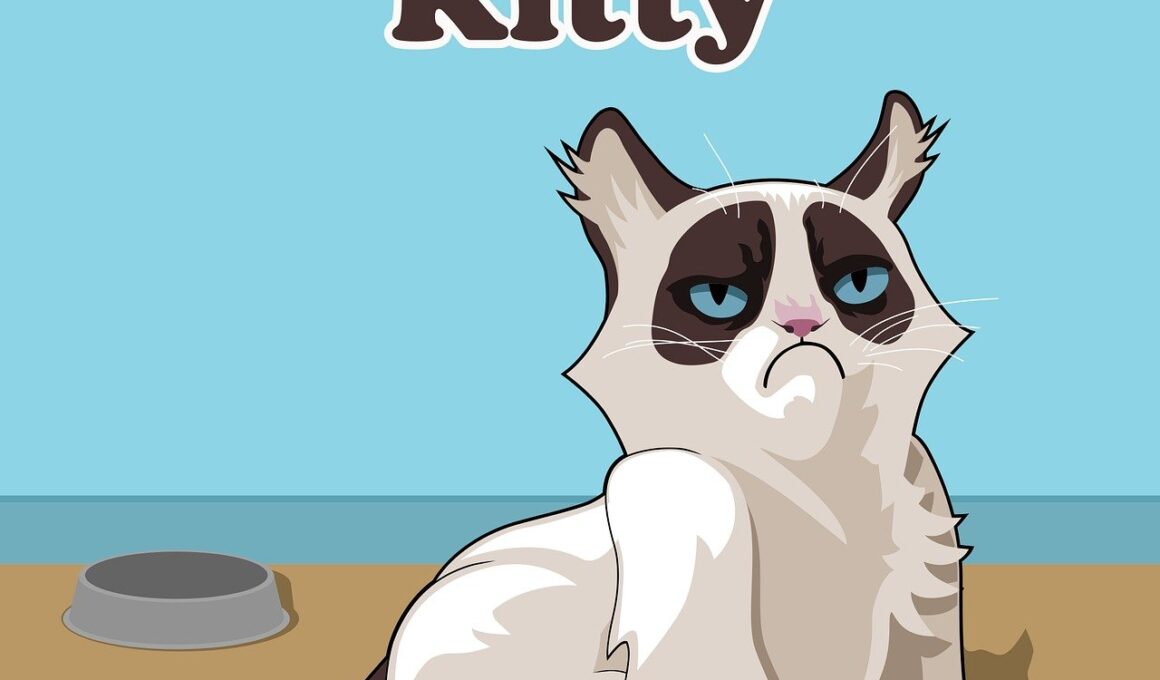The Use of Functional Foods in Enhancing Cat Health Outcomes
Functional foods play a crucial role in improving feline health outcomes, providing not just nutrition but also therapeutic benefits. These foods can enhance the overall wellbeing of cats by offering additional bioactive compounds. Examples include probiotics, prebiotics, and omega-3 fatty acids. Each of these components can address specific health issues such as obesity, joint problems, or digestive disorders. Including such foods in your cat’s diet can significantly impact their quality of life and longevity. Recent studies support the notion that functional foods can reduce the incidence of chronic diseases in cats. Furthermore, incorporating foods with specific functional properties ensures they receive a balanced diet enriched with beneficial nutrients. Consulting with a veterinarian before adding these foods to your cat’s diet is advisable. It’s essential to ensure all modifications suit the individual health needs of your cat. Additionally, the market is increasingly aware of these benefits, leading to the design of better formulated commercial diets. As a result, pet owners are now more informed about making dietary choices that enhance their cat’s health outcomes and provide optimal nutrition for their beloved companions.
The evaluation of functional foods in veterinary nutrition continues to expand, revealing new insights into their efficacy. Research indicates that incorporating these foods results in healthy weight management, better digestion, and improved skin and coat appearance. For instance, antioxidants found in certain fruits and vegetables help combat oxidative stress, enhancing your cat’s immune response. Additionally, the inclusion of fiber helps with gastrointestinal health, promoting regularity and reducing hairball formation. Other research highlights the importance of essential fatty acids in maintaining cognitive function and reducing inflammation in aging cats. Studies have shown that aged cats on omega-3 enriched diets exhibit better cognitive skills and mood regulation. Thus, integrating functional foods is not merely a trend but a scientifically supported method to enhance a feline’s diet. The versatility of these foods allows for various applications, from weight management formulas to age-specific nutrition. Moreover, pet food companies are continuously innovating to incorporate these beneficial ingredients. Overall, functional foods represent a significant shift in how we approach cat nutrition, emphasizing prevention and wellness through diet.
Research into the use of functional foods is proving indispensable in developing specialized diets for cats. For example, nutritional targeting using functional foods can aid in the management of feline diseases. Such foods potentiate specific health benefits, making tailored nutrition essential for specific cat demographics. Younger cats might benefit from formulations rich in protein and fatty acids for growth, while senior felines may require antioxidant-rich diets to combat age-related health issues. Functional foods are not only beneficial for disease-specific diets but also for general health maintenance. They provide holistic nutrition that strengthens the body’s defenses against potential health threats. Furthermore, these foods contribute to the prevention of nutrient deficiency, which cats are particularly susceptible to due to their obligate carnivore status. As pet owners seek improved health outcomes, understanding the role of functional foods becomes paramount in making informed dietary choices. Knowledgeable owners can now explore the plethora of available options, ensuring their cats receive holistic nutrition. This shift in focus toward functional ingredients marks a progressive evolution in feline dietary planning, aimed at promoting health and wellness effectively.
The Role of Probiotics and Prebiotics
Probiotics and prebiotics serve a pivotal role in enhancing cat nutrition and digestive health. Probiotics are live microorganisms that provide health benefits, particularly for the gut. Studies have shown that administering probiotics helps restore gut flora balance, especially after antibiotic treatment. Additionally, these beneficial bacteria can improve nutrient absorption and bolster the immune system. On the other hand, prebiotics act as food for these beneficial microorganisms, fostering their growth. Together, they create a synergistic effect essential for maintaining optimal gut health. Regular consumption of such functional ingredients can reduce gastrointestinal disturbances and promote overall vitality in cats. Incorporating probiotic and prebiotic-rich foods into your cat’s diet ensures a robust digestive system. It means fewer vet visits for digestive issues and better management of existing conditions. A well-functioning gut also reflects positively on your cat’s skin, coat, and even mood. The inclusion of these functional ingredients is a practical approach to implementing better nutritional practices in feline dietary regimens. As the understanding of gut health evolves, so does the potential for enhanced functional nutrition.
Another critical component of functional foods is the enrichment with omega-3 fatty acids, which are known for their anti-inflammatory properties and overall health benefits. Cats, especially those prone to joint issues or obesity, can greatly benefit from incorporating these fatty acids into their diets. Omega-3s not only support joint health but also promote heart health and cognitive function. Thus, they are crucial for all age groups of cats, not merely aging felines. By feeding your cat diets fortified with omega-3s, you’re contributing to their long-term vitality and reducing the risks associated with chronic diseases. Furthermore, omega-3s can also improve coat condition, reducing shedding and promoting luster. Their anti-inflammatory effects play a significant role in managing conditions such as arthritis and skin allergies. The practical application of such dietary fats is straightforward, often found in fish oil supplements or specially formulated cat foods that include these essential fatty acids. As awareness of omega-3 benefits grows, many cat owners are increasingly considering them as indispensable dietary additions designed for health optimization, setting a higher standard for feline nutrition.
Weight management is an ongoing challenge in feline health, making the role of functional foods more crucial. Obesity can lead to numerous health complications, including diabetes, heart disease, and joint problems. Therefore, employing functional foods designed for weight control is highly beneficial. Specific ingredients such as high-fiber components help create a feeling of fullness that aids in weight loss efforts. Fiber not only prevents overeating but also supports better digestion and regularity. Incorporating functional foods with lower calorie densities enables owners to provide satisfying meals without the excess calories that contribute to obesity. Moreover, products fortified with L-carnitine can enhance fat metabolism, further supporting weight management strategies. A balanced approach to nutrition is essential to help curb obesity while ensuring all nutritional needs are met. As the recommendations for managing feline weight evolve, functional foods are at the forefront, allowing for a more strategic approach to feeding. By applying an integrative strategy focused on functional foods, owners can not only manage their cat’s weight but also enhance their overall health outcomes.
In conclusion, the use of functional foods represents a significant advancement in feline nutritional practices. By focusing on specific health benefits, these innovative dietary choices pave the way for improved health outcomes. As research continues to evolve, new functional ingredients are constantly being introduced to the market. The impact of such foods on feline wellness is profound, providing necessary nutrients that also confer disease-fighting properties. The integration of functional foods into everyday cat diets promotes wellness through targeted nutrition. As more pet owners prioritize the health of their feline companions, understanding and leveraging these functional benefits becomes essential. Accessibility to products enriched with functional ingredients has never been greater, making dietary changes more feasible. With increased awareness and collaboration among veterinarians, nutritionists, and pet owners, we can work towards better health standards for our cats. Finally, the future of feline nutrition continues to look promising, thanks to ongoing research and improvements in the development of functional food options. Thus, we encourage all cat owners to explore the benefits of functional foods and make informed nutrition decisions.
Further Considerations in Cat Nutrition
While the focus on functional foods gains traction, understanding the entire spectrum of cat nutrition remains important. Pet owners must consider not only the functional benefits but also the overall caloric and nutritional balance required. Every cat has unique needs based on their age, size, and health status. Therefore, consulting with a veterinary nutritionist whenever introducing new foods is beneficial. Moreover, reading ingredient labels and understanding animal digestibility can help owners make informed decisions. The presence of whole meats, grains, and enriching ingredients should guide purchasing decisions. Moreover, education around diet formulation must encompass potential allergies, intolerances, and specific dietary needs. Individualizing the diet is essential to cater to different breeds with varying predispositions to health issues. Furthermore, the emotional and behavioral aspects of feeding cannot be overlooked, as stress and anxiety can influence eating habits. Thus, combining functional foods with a holistic understanding of nutrition ensures we meet the comprehensive needs of our feline companions.


